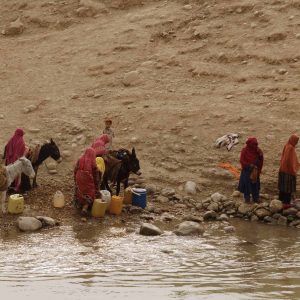Federal Water Tap, April 2: Environmental Reviews for Pebble Mine, Monterey Bay Desalination
The Rundown
NOAA endorses a smaller Monterey Bay desalination facility than was proposed while the Army Corps begins its environmental review of the Pebble Mine. The Justice Department fines chemical and oil companies for dumping harmful substances into a Louisiana bayou. Hoopa Valley tribe disputes the Bureau of Reclamation’s Klamath basin water plan. And lastly, a national drought council holds an executive meeting.
By the Numbers
$11 million: Fine levied against four oil and chemical companies for dumping PCBs, metals, pesticides, and other hazardous products into Bayou d’Inde in Louisiana. The companies are Citgo, Occidental Chemical, OXY, and PPG. (Justice Department)
News Briefs
Pruitt Barnstorms California
On a trip west, Scott Pruitt, the EPA administrator, met with farmers in Riverside and Stanislaus counties and visited almond orchards and an almond processing facility. He was accompanied by Rep. Ken Calvert and Rep. Jeff Denham, both Republicans.
Tribe Objects to Reclamation’s Klamath Plan
The Hoopa Valley tribe objects to the Bureau of Reclamation’s plan to reduce water releases from Klamath basin dams, the Herald and News reports. The court-ordered releases are designed to flush the river of a parasite that attacks salmon. One such release will occur but Reclamation says a reserve of water for a second flush will not be available.
The Klamath basin is significantly dry right now (spring-summer inflows to Upper Klamath Lake are projected at 56 percent of average) and Reclamation is balancing environmental demands and water deliveries to irrigators.
Studies and Reports
Pebble Mine
The Army Corps of Engineers announced that it will begin gathering public input for its environmental review of the Pebble Mine, in Alaska’s Bristol Bay watershed.
Scoping is only 30 days, a relatively short time for a large project. Scoping is the process by which the public gets to comment on the options that will be analyzed and concerns that should be addressed. By comparison, scoping for the ongoing review of Columbia River dams, also being coordinated by the Army Corps, was initially more than three months. To be fair, that scoping process included meetings in four states.
Allowing the developers of the proposed mine to apply for a permit was part of a deal struck with the U.S. Environmental Protection Agency last year. The EPA’s opinion is that the mine, which would be located upstream of one of the world’s most abundant salmon fisheries, should not be developed.
California Desalination Project Review
NOAA and the California Public Utilities Commission endorsed a scaled-down desalination facility proposed for Monterey Bay, which is also a national marine sanctuary, according to a final environmental impact statement.
California American Water Company proposed a 9.6 million-gallon-per-day (mgd) facility near Marina, California, with intake pipes that would not rest in open water. Instead, the intake will be drilled underground from the shore and, at their end, sit some 200 feet below the seabed. They will draw water through the sand.
State and federal agencies approved the subsurface “slant” wells, but they want a smaller facility, some 6.4 mgd. The rest of the water will be sourced from a recycled water project in Monterey County.
The desalination project will allow CalAm to reduce diversions from the Carmel River, reduce pumping of a coastal aquifer, and replenish water to the aquifer.
The brine will be diluted with wastewater and discharged through an existing pipe.
On the Radar
Drought Council Meeting
NIDIS, a federal drought monitoring program, will hold a public meeting of its executive council on April 17, in Washington, D.C. On the agenda: federal drought coordination efforts, monitoring networks, research, and water utility risk. Register here to attend.
Federal Water Tap is a weekly digest spotting trends in U.S. government water policy. To get more water news, follow Circle of Blue on Twitter and sign up for our newsletter.
Brett writes about agriculture, energy, infrastructure, and the politics and economics of water in the United States. He also writes the Federal Water Tap, Circle of Blue’s weekly digest of U.S. government water news. He is the winner of two Society of Environmental Journalists reporting awards, one of the top honors in American environmental journalism: first place for explanatory reporting for a series on septic system pollution in the United States(2016) and third place for beat reporting in a small market (2014). He received the Sierra Club’s Distinguished Service Award in 2018. Brett lives in Seattle, where he hikes the mountains and bakes pies. Contact Brett Walton




Leave a Reply
Want to join the discussion?Feel free to contribute!